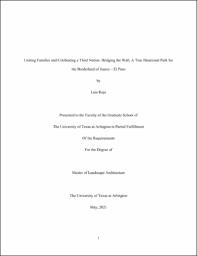| dc.description.abstract | According to the Migration Policy Institute (MPI), an estimated 11.3 million undocumented immigrants reside in United States (U.S.) of which 53 percent are Mexican (Gelatt & Zong, 2018). Many of these immigrants have not been able to see their families in Mexico for numerous years. Due to the lack of documentation, it is difficult to determine the exact number of separated families. By considering remittance inflow to Mexico, that is, money sent from individuals in the U.S. to individuals in Mexico, the researcher can gain an understanding of how many Mexican families exist in a state of separation (Orozco, 2015). The U.S. is the top remittance-sending country in the world, with over 68 billion dollars sent in 2017(World Bank, 2020). Mexico is its primary beneficiary, receiving over 30 billion dollars, nearly half of the total amount of remittances sent. Although, Mexican migration into the U.S. has slowed down significantly, with only a one percent increase between 2010 and 2016, the remittance inflow to Mexico has remained constant and not decreased as would have been expected. According to surveys conducted by political scientist, Manuel Orozco (2015), the median length of time Mexican migrants remain in the U.S. without returning to Mexico has increased from 7 years to 12 years due to stricter immigration enforcement. As a result, a majority of Mexican immigrants are sending money home via money transfer instead of physically bringing cash home to their families. Most Mexican immigrants fear leaving the U.S. and not being able to return leading to extended periods of family separation (Aizenman, 2017). As partisan politics divide the nation on various issues, which include immigration and the construction of a wall along the US - Mexican border, the objective of this thesis is to develop a conceptual design that will challenge the interstice of the borderland at El Paso-Juarez. This research is to study and assess the cultural integration of the borderlands to inform the design of a binational park for the El Paso – Juarez region, which reunites people and celebrates the friendship of the two bordering nations. A description strategy method, which combined multiple sources, was utilized for the development of the design proposal for a binational park in the border region of El Paso and Ciudad Juarez (Deming & Swaffield, 2011). The first step was to collect literature to understand the history and culture of the US- Mexico border region. The second step was to use precedent studies. These precedent studies were a combination of existing binational parks in North America, a pedestrian bridge on the US- Mexico Border, and border wall design concepts for the US-Mexico border. The precedent studies were used to aid the design process for the binational park on the El Paso-Juarez border region. The third step was to utilize two of the binational parks from the precedent studies as case studies. These parks were chosen based on typology and the suitability for the location of the proposed binational park in El Paso- Ciudad Juarez. The case studies were analyzed and evaluated based on: (a) location and context, (b) description, (c) major uses and users, and (d) successful and unsuccessful features. The findings from the design process were then used for a binational park in El Paso- Ciudad Juarez region. Based on data such as literature review, precedent studies, and in-depth case studies, the research explored the contingency of a landscape for the unity of a third nation, that is a place bridging national boundaries and celebrating the history and cultural ties of the two neighboring cities. The design proposal considered a large gathering space for the celebration of history and culture of the El Paso- Juarez region. The design proposal also provided a variety of spaces for people to engage in social activities and family unification. | |


